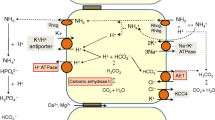Summary
The effect of the loop diuretic furosemide (4-chloro-N-furfuryl-5-sulfamoyl-anthranilic acid) on the thiol-dependent, ouabain-insensitive K(Rb)/Cl transport in low K+ sheep red cells was studied at various concentrations of extracellular Rb+, Na+ and Cl−. In Rb+-free NaCl media, 2×10−3 m furosemide inhibited only one-half of thiol-dependent K+ efflux. In the presence of 23mm RbCl, however, the concentration of furosemide to produce 50% K+ efflux inhibition (IC50) was 5×10−5 m. In Rb+ containing NaCl media, the inhibitory effect of 10−3 m furosemide was equal to that caused by NO −3 replacement of Cl− in the medium. The apparent synergistic action of furosemide and external Rb+ on K+ efflux was also seen in the ouabain-insensitive Rb+ influx. A preliminary kinetic analysis suggests that furosemide binding alters both maximal K+(Rb+) transport and apparent external Rb+ affinity. In the presence of external Rb+, Na+ (as compared to choline) exerted a small but significant augmentation of the furosemide inhibition of K+(Rb+) fluxes. There was no effect of Cl− on the IC50 value of furosemide. As there is no evidence for coupled Na+K+ cotransport in low K+ sheep red cells, furosemide may modify thiol-dependent K+(Rb+/Cl flux or Rb+ (and to a slight degree Na+) modulate the effect of furosemide.
Similar content being viewed by others
References
Aiton, J.F., Chipperfield, A.R., Lamb, J.F., Ogden, P., Simmons, N.L. 1981. Occurrence of passive furosemidesensitive transmembrane potassium transport in cultured cells.Biochim. Biophys. Acta 646:389–398
Aull, F. 1982. Specific drug sensitive transport pathways for chloride and potassium ions in steady-state Ehrlich mouse ascites tumor cells.Biochim. Biophys. Acta 688:740–746
Bakker-Grunwald, T. 1981. Hormone induced diuretic-sensitive potassium transport in turkey erythrocytes is anion dependent.Biochim. Biophys. Acta 641:427–431
Bauer, J., Lauf, P.K. 1983. Thiol-stimulated passive K/Cl transport in sheep red cells: III. Differential reactivity of membrane SH groups with N-ethylmaleimide and iodoacetamine.J. Membrane Biol. 73:257–261
Brazy, P.C., Gunn, R.B. 1975. Furosemide inhibition of chloride transport in human red blood cells.J. Gen. Physiol. 68:583–599
Cornish-Bowden, A. 1976. Principles of Enzyme Kinetics. pp. 52–70. Butterworth, London-Boston.
Dunham, P.B., Ellory, J.C. 1981. Passive potassium transport in low potassium sheep red cells: Dependence upon cell volume and chloride.J. Physiol. (London) 318:511–530
Dunham, P.B., Stewart, G.W., Ellory, J.C. 1980. Chlorideactivated passive potassium transport in human erythrocytes.Proc. Natl. Acad. Sci. USA 77:1711–1715
Ferdinand, W. 1976. The Enzyme Molecule. pp. 138–161. J. Wiley and Sons, London-New York-Sidney-Toronto
Forbush, B., Palfrey, H.C. 1983.3H-Bumetanide binding to membranes isolated from dog kidney outer medulla. Relationship to the Na,K,Cl-cotransport system.J. Biol. Chem. (in press)
Frizzell, R.A., Field, M., Schultz, S.G. 1979. Sodium-coupled chloride transport by epithelial tissues.Am. J. Physiol. 236:F1-F8
Gargus, J.J., Slayman, C.W. 1980. Mechanism and role of furosemide-sensitive K+ transport in L cells: A genetic approach.J. Membrane Biol. 52:245–256
Geck, P., Pietrzyk, C., Burckhardt, B.C., Pfeiffer, B., Heinz, E. 1980. Electrically silent contransport of Na+, K+, and Cl− in Ehrlich cells.Biochim. Biophys. Acta 600:432
Haas, M. 1982. Volume-sensitive and catecholamine-stimulated ion transport pathways in duck red cells. Ph.D. Thesis, Duke University, Durham, North Carolina
Haas, M., McManus, T.J. 1983. Bumetanide inhibits (Na+K+2Cl) co-transport at a chloride site.Am. J. Physiol. (in press)
Haas, M., Schmidt, W.F., III, McManus, T.J. 1982. Catecholamine stimulated ion transport in duck red cells: Gradient effects in electrically neutral (Na+K+2Cl) co-transport.J. Gen. Physiol. 80:125–147
Hoffman, E.K., Sjoholm, G., Simonsen, L.O. 1981. Anioncation co-transport and volume regulation in Ehrlich ascites tumour cells.J. Physiol. (London) 319:94–95P
Lauf, P.K. 1981. A chemically unmasked, chloride dependent K+ transport in low K+ sheep red cells: Genetic and evolutionary aspects.In: Erythrocyte Membranes. 2: Recent Clinical and Experimental Advances. W.C. Kruckenberg, T.W. Eaton and P.J. Brewer, editors, pp. 13–30. Alan R. Liss, New York
Lauf, P.K. 1982. Active and passive cation transport and its association with membrane antigens in sheep erythrocytes: Developments and trends.In: Membranes and Transport. A.N. Martonosi, editor. Volume 1, pp. 553–557. Plenum, New York
Lauf, P.K. 1983. Thiol activated, passive K/Cl transport in low K+ sheep red cells: Effect of Cl− replacement and of furosemide.Biophys. J. 41:165a
Lauf, P.K. 1983. Thiol-dependent passive K/Cl transport in sheep red cells: I. Dependence on chloride and external K+[Rb+] ions.J. Membrane Biol. 73:237–246
Lauf, P.K. 1983. Thiol-dependent passive K/Cl transport in sheep erythrocytes: II. Loss of Cl− and N-ethylmaleimide sensitivity in maturing high K+ cells.J. Membrane Biol. 73:246–256
Lauf, P.K., Theg, B.E. 1980. A chloride dependent K+ flux induced by N-ethylmaleimide in genetically low K+ sheep and goat erythrocytes.Biochem. Biophys. Res. Commun. 92:1422–1428
McRoberts, J.A., Erlinger, S., Rindler, M.J., Saier, M.H., Jr. 1982. Furosemide-sensitive salt transport in the Madin-Darby canine kidney cell line. Evidence for the co-transport of Na+, K+, and Cl−.J. Biol. Chem. 257:2260
Musch, M.W., Orellana, S.A., Kimberg, L.S., Field, M., Halm, D.R., Krasny, E.J., Jr., Frizzell, R.A. 1982. Na+−K+−Cl− co-transport in the intestine of a marine teleost.Nature (London) 300:351–353
Palfrey, H.C., Feit, P.W., Greengard, P. 1980. cAMP-stimulated cation cotranspor in avian erythrocytes: Inhibition by “loop” diuretics.Am. J. Physiol. 238:C139–148
Palfrey, H.C., Greengard, P. 1981. Hormone-sensitive ion transport systems in erythrocytes as models for epithelial ion pathways.Ann. NY Acad. Sci. 372:291–306
Wiley, J.S., Cooper, R.S. 1974. A furosemide-sensitive cotransport of sodium plus potassium in the human red cell.J. Clin. Invest. 53:745–755
Author information
Authors and Affiliations
Rights and permissions
About this article
Cite this article
Lauf, P.K. Thiol-Dependent passive K/Cl transport in sheep red cells: IV. Furosemide inhibition as a function of external Rb+, Na+, and Cl− . J. Membrain Biol. 77, 57–62 (1984). https://doi.org/10.1007/BF01871100
Received:
Revised:
Issue Date:
DOI: https://doi.org/10.1007/BF01871100




